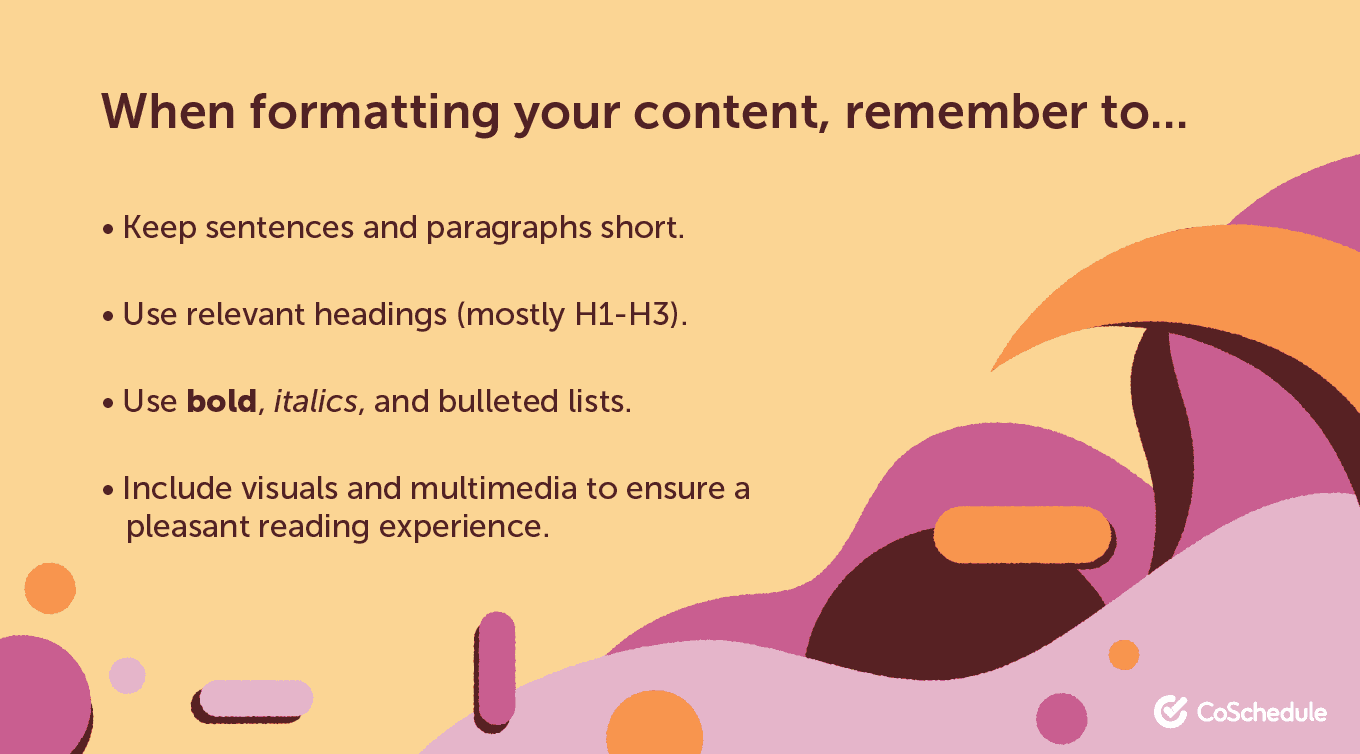Quality Content: The Ultimate Guide to Creating Content that Engages and Converts
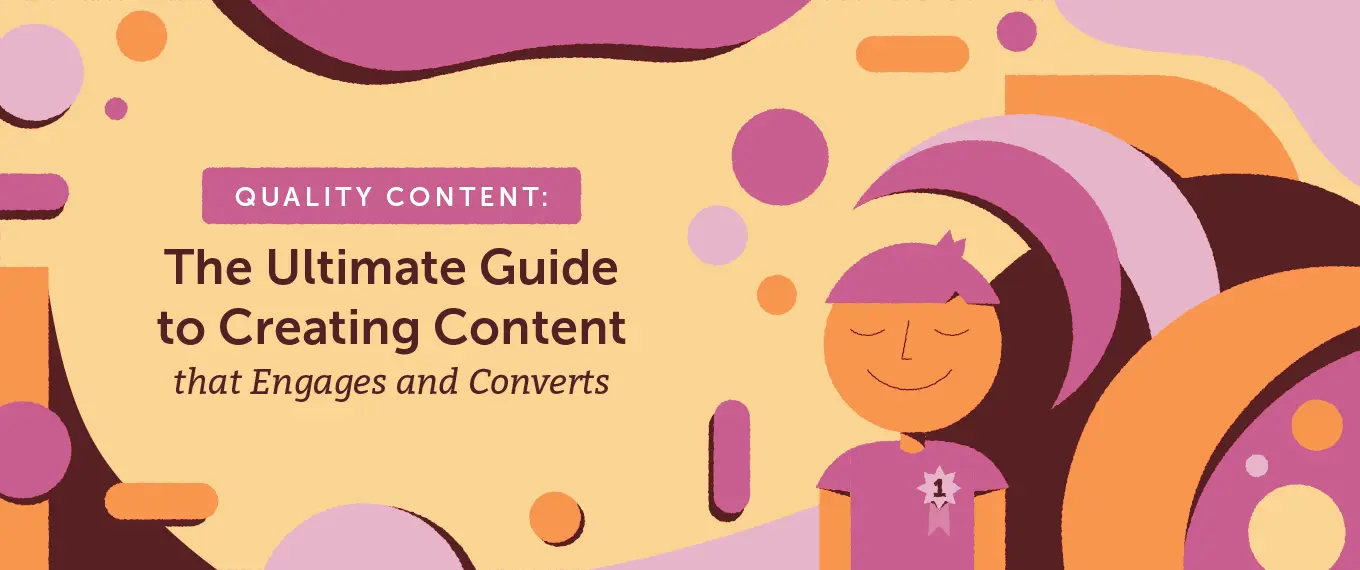 A lot has been said about the power of content marketing.
According to the Content Marketing Institute, content marketing costs 62% less compared to outbound marketing, yet it generates three times as many leads as outbound marketing.
There’s one key ingredient that can make or break the success of your content marketing campaign: content quality. Content quality goes beyond simply hitting a certain word count, formatting your content in a certain way, or ensuring your content is well-designed.
A lot more goes into creating quality content, and this article addresses them.
Let’s start by defining what quality content is.
A lot has been said about the power of content marketing.
According to the Content Marketing Institute, content marketing costs 62% less compared to outbound marketing, yet it generates three times as many leads as outbound marketing.
There’s one key ingredient that can make or break the success of your content marketing campaign: content quality. Content quality goes beyond simply hitting a certain word count, formatting your content in a certain way, or ensuring your content is well-designed.
A lot more goes into creating quality content, and this article addresses them.
Let’s start by defining what quality content is.
Quality content: the ultimate guide to creating content that engages and converts.
Click To TweetDownload Your Content Quality Checklist
If, by the end of your research and creation of your content, you don’t feel confident in what you’re publishing, use this checklist. Our provided content quality checklist is the perfect method to understanding whether your content is ready to be seen by your target audience. If you answer any of these questions with a hard “no” or even a “eh… maybe,” then maybe you should go back and clarify — if not for your future readers, then for yourself — so you’re confident in your hard work.What is Quality Content?
Before we get into the exact step-by-step process you can follow to create quality content, it is important to first define quality content. While many tend to appraise content based on how long it is or the number of words it contains, the reality is that so much more goes into determining the quality of a piece of content than its length. Simply put, quality content is content that fully addresses a reader’s problem and achieves the purpose for which it was created. Of course, there’s a lot that goes into creating quality content, but — at the most basic sense — quality content should aim to do the following two things:- Address the problem that made a reader choose to read it.
- Achieve a measurable purpose; this could be increasing conversions, boosting engagement, eliciting a certain reaction in the audience, etc.
Does Length Matter When It Comes to Quality Content?
Of course, we’ve established that content quality isn’t always about length, but does content length matter in any way? I would be answering this question based on what the data says. In an article addressing the issue of content length by fellow CoSchedule contributor, Ann Smarty, a few core studies were cited that show stats about content length: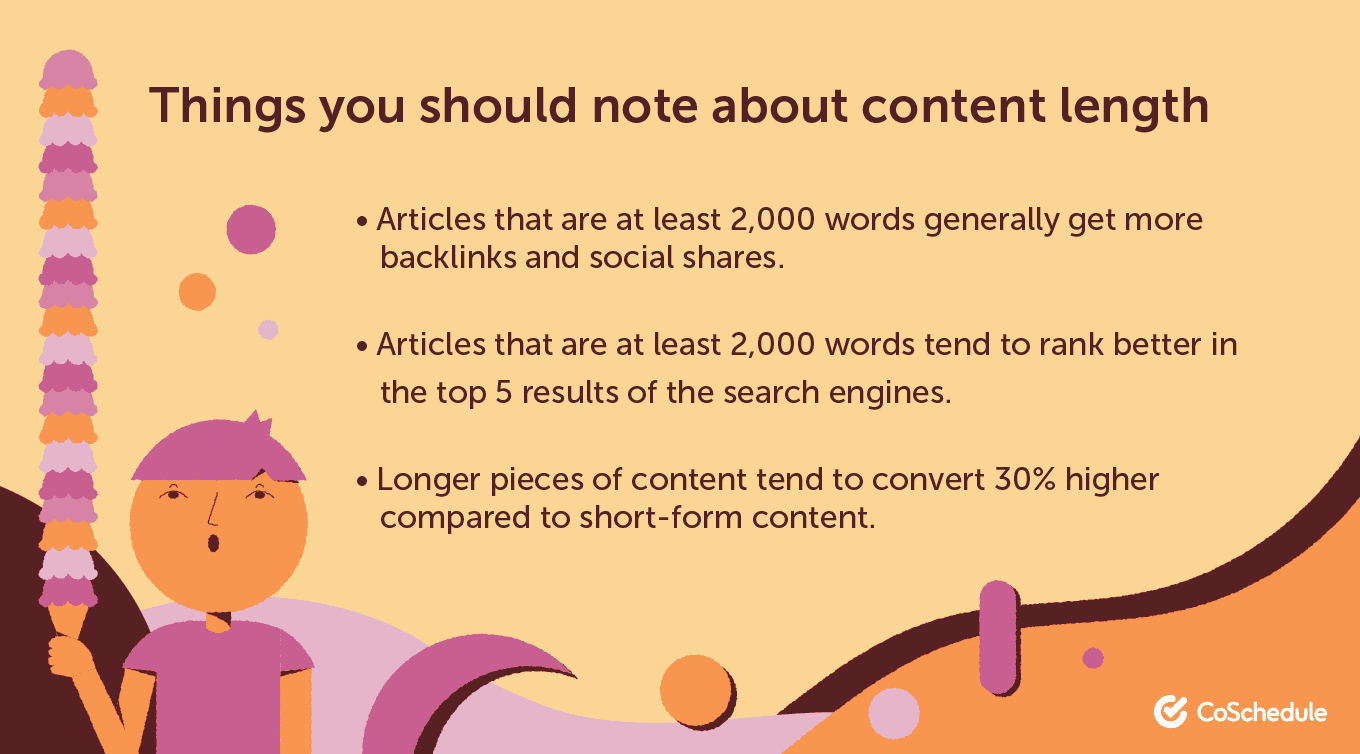 These findings were further corroborated by a few other key studies:
These findings were further corroborated by a few other key studies:
- Backlinko’s massive analysis of 912 million blog posts found that long-form content tends to get an average of 77.2% more links compared to shorter content.
- The Backlinko study also found that longer pieces of content tend to generate more social shares — with the sweet spot being around 1,000–2,000 words. The difference here is that Backlink found the average 1,000–2,000 word article getting 56.1% more social shares than content less than 1,000 words in length.
- Ahrefs’ analysis of 900 million pages also came to the same conclusion: longer content (up to 2,000 words) tends to get more backlinks and organic traffic.
Longer content is more favorable to improve social shares, link generation, engagement, and search engine rankings.
Click To TweetQuality Content and SEO: Does It Really Matter?
A lot of people tend to be obsessive about Google’s thinking when it comes to creating content, but should SEO be taken into consideration for creating quality content? The answer to this question isn’t a simplistic one.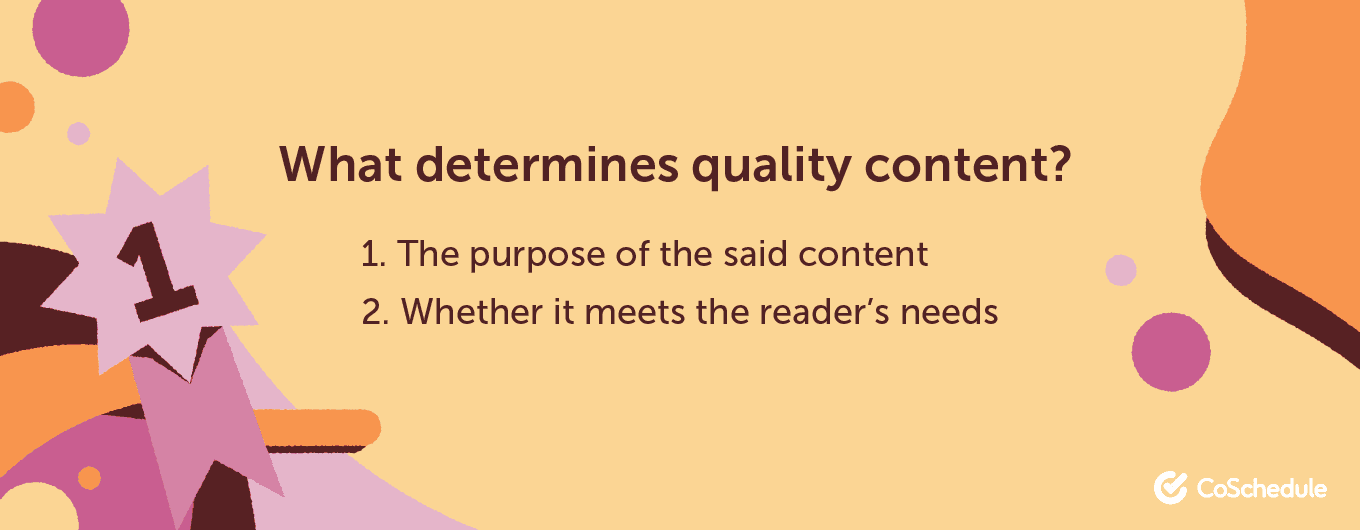 In some unique cases, you might have to create content exclusively for an audience you’ve already built. In this case, you can afford to ignore SEO completely.
On the other hand, if the purpose of your content is to get traffic, conversions, and sales, you don’t want to ignore SEO. Research shows that 93% of online experiences start with a search engine.
In other words, you stand to lose as many as 93% of your potential audience and customers if you ignore SEO.
That isn’t a chance I would be willing to take!
That said, writing your content with SEO in mind does not equal keyword stuffing or other shady SEO techniques. Instead, it’s about understanding the language that your target audience is speaking. This means understanding what your audience will be typing into the search engines to find the kind of content you’re creating. That’s keyword research.
If, for example, you want to create a guide about extreme fatigue that lasts longer than six months, your article could be titled “Extreme Fatigue that Lasts Longer than Six Months”, and it would still be meaningful.
Now, let’s take a look at some data to see how many people are searching for that term:
In some unique cases, you might have to create content exclusively for an audience you’ve already built. In this case, you can afford to ignore SEO completely.
On the other hand, if the purpose of your content is to get traffic, conversions, and sales, you don’t want to ignore SEO. Research shows that 93% of online experiences start with a search engine.
In other words, you stand to lose as many as 93% of your potential audience and customers if you ignore SEO.
That isn’t a chance I would be willing to take!
That said, writing your content with SEO in mind does not equal keyword stuffing or other shady SEO techniques. Instead, it’s about understanding the language that your target audience is speaking. This means understanding what your audience will be typing into the search engines to find the kind of content you’re creating. That’s keyword research.
If, for example, you want to create a guide about extreme fatigue that lasts longer than six months, your article could be titled “Extreme Fatigue that Lasts Longer than Six Months”, and it would still be meaningful.
Now, let’s take a look at some data to see how many people are searching for that term:
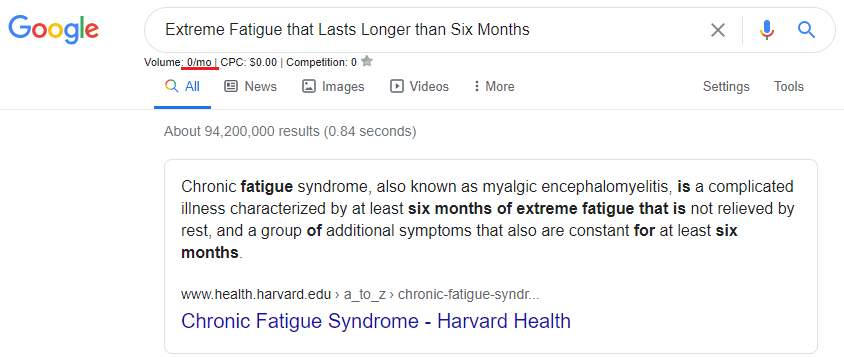 As you can see, there are exactly ZERO people searching for that term monthly.
The interesting thing is that extreme fatigue that lasts longer than six months has a medical term that people generally use when trying to learn more about it. This term is called “chronic fatigue syndrome”.
Now, let’s say your article is titled “Chronic Fatigue Syndrome — All You Need to Know” and focuses on using this term — which is the language people trying to learn about that condition are typing into the search engines — what comes up? Have a look:
As you can see, there are exactly ZERO people searching for that term monthly.
The interesting thing is that extreme fatigue that lasts longer than six months has a medical term that people generally use when trying to learn more about it. This term is called “chronic fatigue syndrome”.
Now, let’s say your article is titled “Chronic Fatigue Syndrome — All You Need to Know” and focuses on using this term — which is the language people trying to learn about that condition are typing into the search engines — what comes up? Have a look:
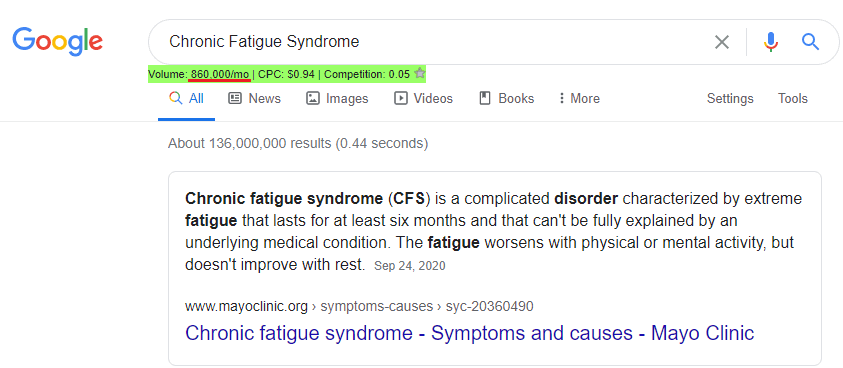 As you can see, that’s a whopping 860,000 people searching for that term every month. Both searchers are trying to learn about the exact same thing, but they are simply using different languages.
An understanding of the right language, in this instance, could mean the difference between having access to zero readers and potentially 860,000 monthly readers.
If the purpose of your article requires that it is read widely, SEO is very important.
You don’t necessarily have to be an SEO whiz, and you don’t need to learn complex techniques. You should at the very least, however, understand the exact terms the majority of your target audience will be using to try to find the information in your article.
In other words, a basic understanding of keyword research and SEO copywriting is important.
As you can see, that’s a whopping 860,000 people searching for that term every month. Both searchers are trying to learn about the exact same thing, but they are simply using different languages.
An understanding of the right language, in this instance, could mean the difference between having access to zero readers and potentially 860,000 monthly readers.
If the purpose of your article requires that it is read widely, SEO is very important.
You don’t necessarily have to be an SEO whiz, and you don’t need to learn complex techniques. You should at the very least, however, understand the exact terms the majority of your target audience will be using to try to find the information in your article.
In other words, a basic understanding of keyword research and SEO copywriting is important.
A basic understanding of keyword research and SEO copywriting is important in creating quality content.
Click To TweetContent Structure and Readability: Why This Matters When Creating Content for the Web
One of the key things you should keep in mind when trying to create quality content is that presentation, structure, and readability are just as important as substance. This is especially true when writing for a web audience. Depending on what source you look at, the average person today is exposed to an estimated 5,000 ads daily, and we have a much reduced attention span — thanks to the Internet and technological distractions. In other words, people are too distracted to read through a long block of text. The importance of structure is very important and cannot be overstated. Here are a few things to keep in mind when working on the structure of your content:- Break things down: Write as if you’re writing for a 6-year-old. Break down your content into sections, keep paragraphs short, and use as few words as you can to get your point across.
- Use HTML headings and subheadings: You should also familiarise yourself with HTML headings and subheadings, as they help break down your content and enhance readability (for both humans and search engines). Most importantly, familiarise yourself with the H1, H2, and H3 tags.
- Use bold, italics, and bullets/numberings: Use bold, italics, and bullets to make important points stand out.
- Spice up your content with visuals and multimedia: An image, they say, speaks a thousand words. Using images and multimedia not only makes your content more readable, it increases its chances of ranking higher and being shared more.
Quality Content Examples for Ideas and Inspiration
Before going into my actual 8-step process for creating quality content, I’d like to share some quality content examples to help inspire you. Here are a few quality content examples you should check out:- Ultimate Guides: We don’t have to go far to find good, ultimate guide examples. CoSchedule has some of the best ultimate guides on marketing-related topics; pretty much everything they create is an ultimate guide of sorts. The ultimate guide to marketing resource management and the ultimate guide to creating an email autoresponder are just a few examples.
- Resource posts/pages: Top10.com, a brand I’m involved with, has some of the best resource posts I’ve come across. Their resource page on the best store builders is very comprehensive at almost 3,500 words. My resource that helps writers get paid has been so successful it’s been read over a million times and linked to by hundreds of people!
- Lists: CoSchedule’s extensive list of marketing tactics includes 35 different marketing tactics you can use, and it’s an encyclopedia of sorts about marketing tactics. There’s also the list of 101 catchy blog title formulas.
- How-Tos: Again, I’ll go with examples from CoSchedule; when you read the article on how to write an about page and how to write a bio, you’ll be left with the impression that you know everything there is to know about the subject. Unsurprisingly, third-party data shows that both of these articles are huge traffic drivers.
8 Steps to Create Quality Content
We've gone over the gist of what the meaning of quality content is, but we should also discuss how one goes about creating that content. Here's my 8-step process: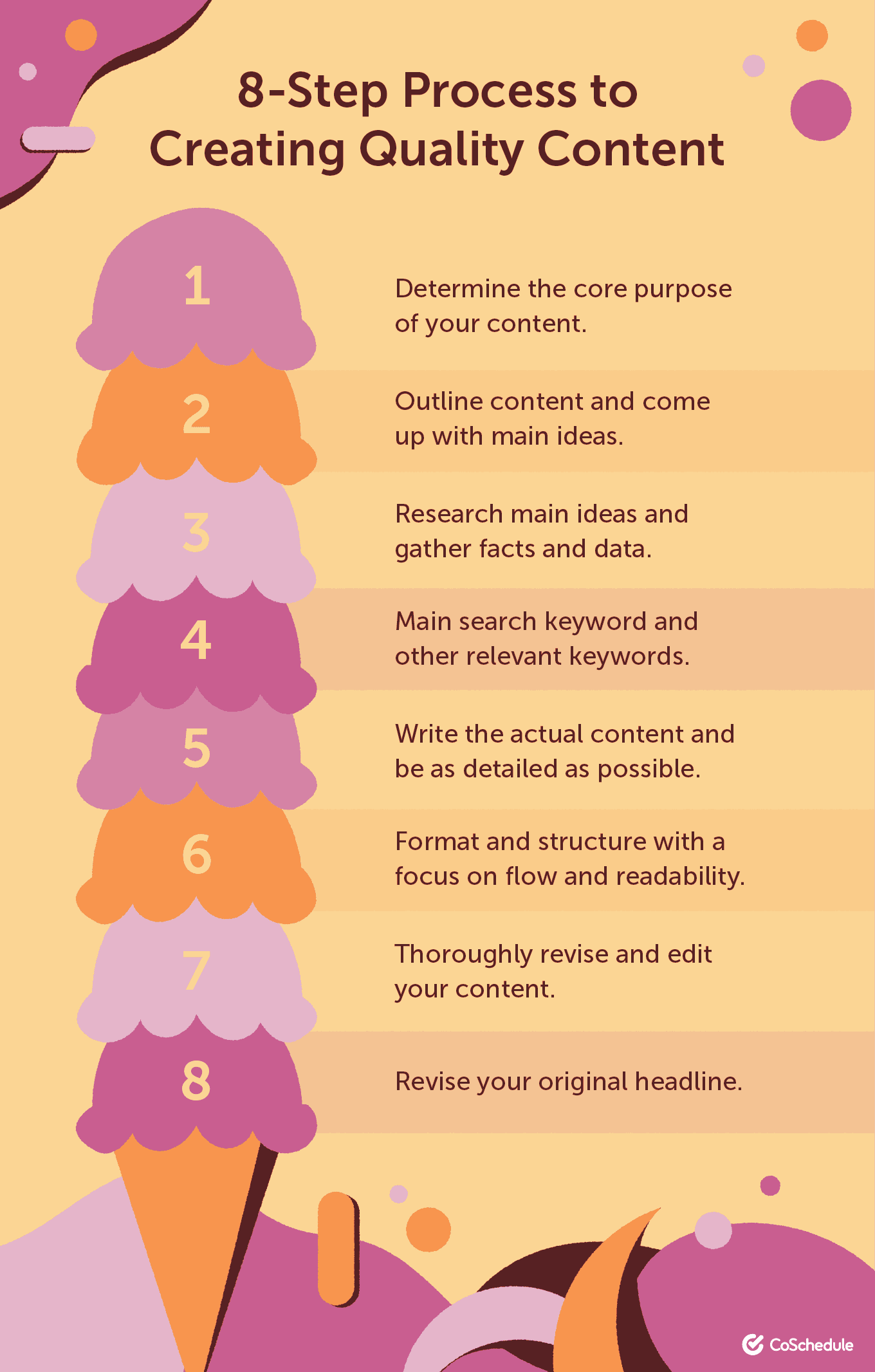
1. Determine the Core Purpose of Your Content
The very first step you should take when trying to create quality content is to determine the purpose of the content. Is the purpose to generate traffic and leads or get existing users to take certain action? If the purpose is to generate traffic, for example, there might be more of a focus on SEO than if the purpose is to have the content inspire existing members of your audience to take certain action.2. Outline Content and Come Up With Main Ideas
Once you’ve determined the purpose of your content, the next step is to outline your content and come up with your main ideas. For me, this process usually involves coming up with a core concept. Example: “Making money as a freelance writer”. Once I come up with a core concept, the next step is to come up with a list of as many of the main issues someone interested in that concept would like to know. Example:- What is freelance writing?
- What kind of opportunities are available to freelance writers?
- How much are freelance writers paid?
- How do you get freelance writing jobs?
- Etc.
3. Research Main Ideas and Gather Facts and Data
This step involves researching the main and supporting concepts/points of the article and then gathering facts and data to help further develop your article. In this case, for example, one of my points from the outline is “how do you get freelance writing jobs?” I can research this point and make a list of all the different ways people can get freelance writing jobs. I note them down and determine the number of ways. This influences the final subheading of this particular point in the article. If I come across five points, I go back to my outline and further develop it based on these facts. Example: “How do you get freelance writing jobs?” becomes: “How to Get Freelance Writing Jobs — The Five Most Effective Ways”, which then has a bulleted list with the five methods:- Freelance job boards
- Cold pitching
- Referrals
- Inbound marketing
- Social media prospecting
4. Main Search Keyword and Other Relevant Keywords
Once the points are outlined, I go ahead and determine my main search keyword. As you can see, this isn’t a purely SEO-driven content creation process. The first step is to understand what the reader wants to know and how to give it to them before finding the keywords they will use to try to find this content. I identify a main keyword first and then as many supporting keywords as possible. Going back to our chronic fatigue syndrome example from earlier:- Main keyword: “Chronic Fatigue Syndrome”
- Supporting keywords: “Chronic Fatigue Syndrome symptoms,” “Chronic Fatigue Syndrome causes,” “Chronic Fatigue Syndrome test,” “Chronic Fatigue Syndrome treatment,” etc.
5. Write the Actual Content and Be as Detailed as Possible
With step 1–4 done, I start the process of actually writing the content — including as much details as I can. More importantly, I consciously write by using the language the target audience will be speaking when trying to find the article. For example, going back to the chronic fatigue syndrome example, instead of talking about “extreme fatigue that lasts longer than six months” throughout the article, I’ll focus on talking about “chronic fatigue syndrome”. That’s what the reader actually wants to know about.Include as many details as you can when you actually start the writing process.
Click To Tweet6. Format and Structure With a Focus on Flow and Readability
I already discussed the importance of content structure earlier on in the article. This is when you get to pay attention to it. Once your content has been fully written, then you carefully edit — ensuring perfect flow and structure. Keep in mind during this step that you’re writing for a web audience.